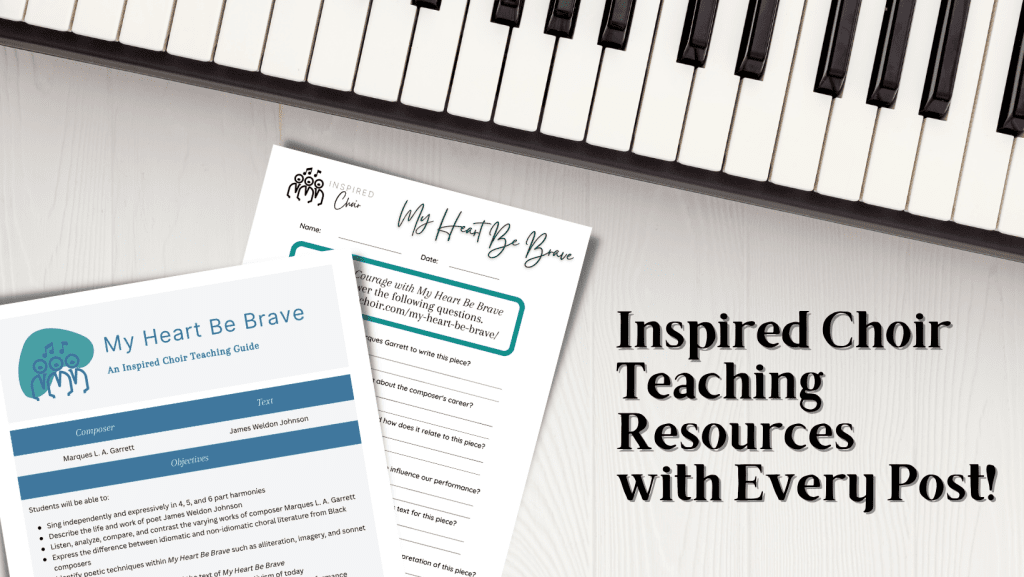Five Marks to Make in Your Choir Music Right Now
This week’s post is short, quick, and to the point. Here’s the point: choir singers, please please please please please mark your choir music. Think you’ll remember the instruction your director gave you on a random Monday in February two months before the concert? Think again. Mark your choir music. Want to make your choir director’s heart melt for joy? Let them see you marking your choir music.
“But, Colleen” – you say – “I don’t know what I’m supposed to mark in my choir music!” Everything. By the end of your concert cycle, your choir music should be a collage of all of the instructors your choir leaders have given you, all of the discoveries you have made, and all of the work you have done along the way.
Below, I aim to get you started on your choir music marking journey with these five suggestions:
- Marking Your Text Emphasis
- Noting Your Dynamics
- Drawing Your Articulation
- Shaping Your Phrasing (Including Breaths!)
- Recording Your Personal Connections

Wait…I’m Allowed To Write In My Music?
Yes indeed you are! And in fact, in most choirs, it is highly encouraged. We choir teachers don’t expect you to remember everything we tell you without a good set of notes. Your music should be that good set of notes that help you be more effective in personal and ensemble rehearsals.
Among other things, I encourage you to mark in your choir music text emphasis and meaning, dynamics, expression, phrasing, breaths, and personal connections. You don’t even have to wait for a choir leader to tell you to mark it – take initiative and get your own thoughts down on the page.
Mark That Text Emphasis
For me, text expression can make or break a piece. If the audience can’t understand the text or are distracted by mispronunciations or emphases in the wrong place, often times the piece won’t land as well as we know it can.
Here is your checklist for marking text emphasis in your choir music:
- Text stress: Which words are most important to the phrase? Circle or underline those words.
- Text meaning: What do the words mean? If the words are in a different language, translate them for yourself. If the words are in complicated prose, translate them to a more relatable meaning for yourself.
- Text pronunciation: Is the text in a language you don’t use on a daily basis? Pull out your International Phonetic Alphabet resources and get to work! Or simply listen to a good recording of your piece and write down their pronunciations for yourself in a way that makes sense to you. No recordings out there? Find someone who speaks the language and ask if they would be willing to record themselves talking for your practice.

Note Those Dynamics
Dynamics are the variations in loudness between notes or phrases within any one piece. These variations, combined with our text stress, expression, and phrasing make our performance aurally interesting.
Here is your checklist for marking dynamics in your choir music:
- At the very least, circle or box any pp, p, mp, mf, f, ff, cresc., decresc., or similar dynamic markings.
- Make the crescendo markings (< or >) as large as you need to actually notice them. (I make mine take up the whole staff).
- If you own your music, or your choir leader okays it, add some color to help. For example:
- Red = loud
- Purple = medium loud
- Blue = soft

Draw Your Articulation
Dynamics is one element under the larger umbrella of musical expression. Other expressive elements include articulation, phrasing, and timbre. Articulation communicates to musicians how to start and end a pitch, how long to hold the note, and the shape of the attack and decay for each individual note.
Here is your checklist for marking articulation in your choir music. Circle or box the following markings and give yourself a note about what to do if you need the reminder:
- Tenuto (-): sing the note for its full length, sometimes with a bit more emphasis on text
- Staccato (.): sing the note short and detached
- Legato: sing the note smoothly and connected
- Slur: sing the note smoothly and connected
- accent (>): emphasize, stress, or give a stronger attack
If you learn well with color or highlighting, consider assigning each of these articulations an associated color. (If you don’t own your music, ask your choir leader first!)
Shape Your Phrasing (Including Breaths!)
Phrasing in choir music is the way an ensemble shapes a sequence of notes in order to allow for expression. Just as we do when speaking, we want to shape our musical phrases so that the most important or interesting words or musical moments are highlighted. To achieve great phrases, we also need to take great breaths, so marking in those breaths is an essential part of the phrase marking process..
Here is your checklist for marking phrasing and breath in your choir music:
- Draw a breath mark ( ‘ ) or line ( | ) to indicate every time you breathe.
- Draw an arch over each phrase, ensuring the peak of your arch matches the peak of the text, melody, or dynamics.

Record Your Personal Connections
Our final mark to make in your choir music is a record of personal connections. If you did some research on the composer and want to keep in mind their story while you are singing, mark it down! If your choir director made a beautiful metaphor about dynamics that really worked for you, mark it down! If there is a moment in the piece that you just love and are so excited to sing, mark it down!
The more information that you have for yourself at your fingertips, the more expressive, connected to, and comfortable you will be with your choir music.
Don’t Miss A Mark!
Would you like to have the ideas from this post in your choir folder for your next study session? Join my email list below and get my free Choir Member Score Study Checklist!

I’d Love to Hear from You!
Have you tried any of these tips for marking your choir music? How did they go? What other marks do we need to make in our choir music? Let me know in the comments section below!
Enjoying the Inspiration?
I have more Take Five For Inspiration Posts for you! Take a look:
- Five Contemporary Choral Composers to Highlight During Women’s History Month 2023
- Five Tips for Practicing Your Choir Music
- Five Ways to Center Black Creatives in Your Choir
- Five Lessons for After the Choir Concert

Teacher Resources!
FREE Mark Your Choir Music Reading Comprehension Worksheet
Reading Comprehension Worksheets pull five key points from the blog post above. Additionally, they ask singers to consider musical decisions they can make with the info from this post. Fill in the form below and get a link to a folder including the Mark Your Choir Music worksheet and all 2023 Jan/Feb posts worksheets.
Check out the Inspired Choir Shop for lesson plan bundles, choir worksheets, and repertoire teaching Guides!















